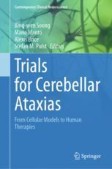Search
Search Results
-
Single-Session Cerebellar Transcranial Direct Current Stimulation Improves Postural Stability and Reduces Ataxia Symptoms in Spinocerebellar Ataxia
Spinocerebellar ataxia (SCA) results in balance and coordination impairment, and current treatments have limited efficacy. Recent evidence suggests...

-
A Chinese Family with Digenic TBP/STUB1 Spinocerebellar Ataxia
Spinocerebellar ataxias (SCAs) are inherited neurodegenerative diseases characterized by loss of balance, coordination, and slurred speech. Recently,...

-
Spinocerebellar Ataxia Type 7: From Mechanistic Pathways to Therapeutic Opportunities
Spinocerebellar ataxiaSpinocerebellar ataxia (SCA) type 7 (SCA7) is a cerebellar and retinal neurodegenerative diseaseNeurodegenerative diseases...
-
Efficacy and Safety of Repetitive Transcranial Magnetic Stimulation in Spinocerebellar Ataxia Type 3: a Systematic Review and Meta‑analysis of Randomized Controlled Trials
Therapeutic alternatives for spinocerebellar ataxia type 3 (SCA3) are limited. Repetitive transcranial magnetic stimulation (rTMS) as a potential...

-
The Phenotypic Spectrum of Spinocerebellar Ataxia Type 19 in a Series of Latin American Patients
Spinocerebellar ataxia 19 (SCA19) represents a rare autosomal dominant genetic disorder resulting in progressive ataxia and cerebellar atrophy. SCA19...

-
Potential Clinical Benefit of Very Long Chain Fatty Acid Supplementation in Spinocerebellar Ataxia Type 34
Spinocerebellar ataxia type 34 (SCA34) is a dominantly inherited disease that causes late-onset ataxia, in association with skin lesions in the form...
-
Altered binaural hearing in pre-ataxic and ataxic mutation carriers of spinocerebellar ataxia type 3
Brainstem degeneration is a prominent feature of spinocerebellar ataxia type 3 (SCA3), involving structures that execute binaural synchronization...

-
Association Between Serum Neurofilament Light Chain and Neurochemistry Deficits in Patients with Spinocerebellar Ataxia Type 3
Extensive evidence supports the claim that the serum neurofilament light chain (sNfL) can be used as a biomarker to monitor disease severity in...

-
A Novel TTBK2 Mutation in a Chinese Pedigree with Spinocerebellar Ataxia 11
Spinocerebellar ataxia type 11 (SCA11) is a rare disease and the tau tubulin kinase 2 ( TTBK2 ) gene was the causative gene. To date, only six SCA11...

-
Severe Neurodevelopmental Disorder in Autosomal Recessive Spinocerebellar Ataxia 13 (SCAR13) Caused by Two Novel Frameshift Variants in GRM1
Autosomal recessive spinocerebellar ataxia 13 (SCAR13) is a neurological disease characterized by psychomotor delay, mild to profound intellectual...
-
A Case of Coexistent Spinocerebellar Ataxia Type 2 and Primary Progressive Multiple Sclerosis—Coincidental or Associated?
Spinocerebellar ataxia type 2 (SCA2) is a dominantly inherited ataxia primarily characterised by progressive cerebellar syndrome, which is developed...

-
CAT Interruption as a Protective Factor in Chinese Patients with Spinocerebellar Ataxia Type 1
Spinocerebellar ataxia type 1 (SCA1) is the third most common type of spinocerebellar ataxias in China. CAT interruptions in the pathogenic alleles...

-
Content Validity of the Modified Functional Scale for the Assessment and Rating of Ataxia (f-SARA) Instrument in Spinocerebellar Ataxia
The functional Scale for the Assessment and Rating of Ataxia (f-SARA) assesses Gait, Stance, Sitting, and Speech. It was developed as a potentially...

-
Two New Families and a Literature Review of ELOVL4-Associated Spinocerebellar Ataxia Type 34
Autosomal dominant variants in ELOVL4 cause spinocerebellar ataxia type 34 (SCA34; ATX- ELOVL4 ), classically associated with a skin condition known as...

-
Spinocerebellar ataxia type 31 (SCA31)
Spinocerebellar ataxia type 31 (SCA31) is one of the most common forms of autosomal-dominant cerebellar ataxia in Japan. SCA31 has a strong founder...

-
Progression of Retinal Ganglion Cell and Nerve Fiber Layer Loss in Spinocerebellar Ataxia 3 Patients
Spectral domain optical coherence tomography (SD-OCT) allows noninvasive measurements of retinal neuron layers. Here, we evaluate the relationship...

-
Serum S100β Levels Are Linked with Cognitive Decline and Peripheral Inflammation in Spinocerebellar Ataxia Type 2
Experimental and clinical studies have indicated a potential role of the protein S100β in the pathogenesis and phenotype of neurodegenerative...

-
Novel CWF19L1 mutations in patients with spinocerebellar ataxia, autosomal recessive 17
Spinocerebellar ataxia, autosomal recessive-17 (SCAR17) is a rare hereditary ataxia characterized by ataxic gait, cerebellar signs and occasionally...

-
Psychometric Validation of the Modified Functional Scale for the Assessment and Rating of Ataxia (f-SARA) in Patients With Spinocerebellar Ataxia
This study aimed to generate evidence to support psychometric validity of the modified functional Scale for the Assessment and Rating of Ataxia...

-
Perceptual and Acoustic Analysis of Speech in Spinocerebellar ataxia Type 1
This study characterizes the speech phenotype of spinocerebellar ataxia type 1 (SCA1) using both perceptual and objective acoustic analysis of speech...

